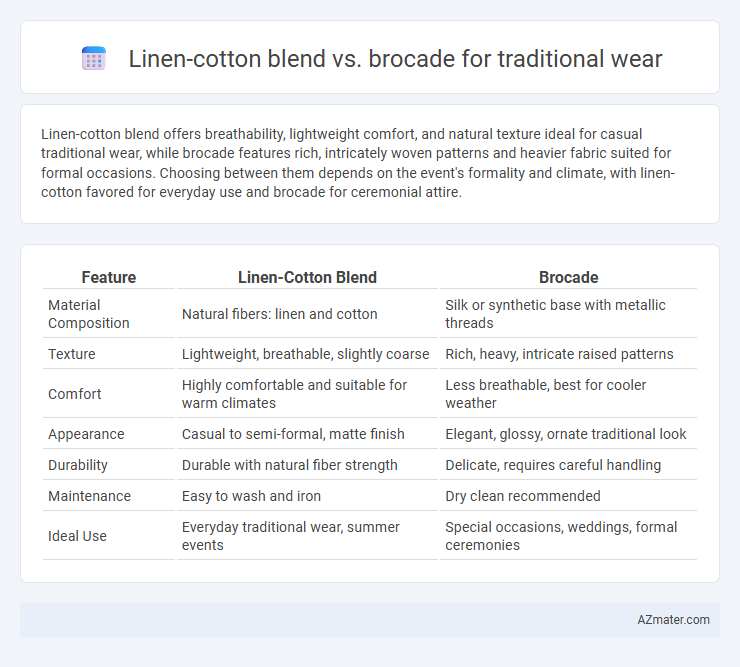Linen-cotton blend offers breathability, lightweight comfort, and natural texture ideal for casual traditional wear, while brocade features rich, intricately woven patterns and heavier fabric suited for formal occasions. Choosing between them depends on the event's formality and climate, with linen-cotton favored for everyday use and brocade for ceremonial attire.
Table of Comparison
| Feature | Linen-Cotton Blend | Brocade |
|---|---|---|
| Material Composition | Natural fibers: linen and cotton | Silk or synthetic base with metallic threads |
| Texture | Lightweight, breathable, slightly coarse | Rich, heavy, intricate raised patterns |
| Comfort | Highly comfortable and suitable for warm climates | Less breathable, best for cooler weather |
| Appearance | Casual to semi-formal, matte finish | Elegant, glossy, ornate traditional look |
| Durability | Durable with natural fiber strength | Delicate, requires careful handling |
| Maintenance | Easy to wash and iron | Dry clean recommended |
| Ideal Use | Everyday traditional wear, summer events | Special occasions, weddings, formal ceremonies |
Introduction: Choosing the Right Fabric for Traditional Wear
Linen-cotton blends offer breathable comfort and natural texture, making them ideal for warm climates and casual traditional wear. Brocade fabrics showcase intricate patterns woven with silk and metallic threads, providing a rich, luxurious appearance suitable for formal occasions and ceremonial attire. Selecting between these materials depends on the event's formality, climate considerations, and desired aesthetic impact in traditional wardrobes.
Overview of Linen-Cotton Blend
Linen-cotton blend fabric combines the breathability and softness of cotton with the durability and natural texture of linen, making it ideal for traditional wear in warm climates. This blend offers moisture-wicking properties and a lightweight feel, ensuring comfort during prolonged use. Compared to brocade, which is heavier and richly patterned, linen-cotton blends provide a subtle, breathable option suitable for casual to semi-formal traditional attire.
What is Brocade?
Brocade is a rich, decorative fabric woven with intricate patterns, often incorporating gold or silver threads, making it a popular choice for traditional wear due to its luxurious appearance and textured feel. Unlike linen-cotton blends, which offer breathability and comfort suited for warmer climates, brocade provides a heavier weight and a regal aesthetic ideal for formal occasions and ceremonial attire. The choice between linen-cotton blend and brocade depends on the desired balance of comfort, durability, and ornate elegance in traditional garments.
Fabric Composition: Linen-Cotton vs Brocade
Linen-cotton blend fabric combines natural fibers, offering breathability, moisture-wicking properties, and softness ideal for comfortable traditional wear in warm climates. Brocade fabric consists of rich, intricately woven silk or synthetic fibers with metallic threads, providing a luxurious texture and ornate patterns suitable for formal and ceremonial attire. The choice between linen-cotton blend and brocade depends on the desired balance between comfort, durability, and opulence in traditional clothing.
Comfort and Breathability Comparison
Linen-cotton blend fabric excels in comfort and breathability due to its natural fibers, offering superior moisture-wicking and temperature regulation ideal for traditional wear in warm climates. Brocade, characterized by its rich, heavy weave and decorative patterns, provides a more luxurious appearance but lacks the same level of air permeability, often making it less comfortable in hot or humid conditions. Prioritizing linen-cotton blend enhances comfort for prolonged wear, while brocade suits formal occasions where aesthetics outweigh breathability.
Aesthetic Appeal and Visual Impact
Linen-cotton blends offer a natural, matte finish with breathable fabric that accentuates subtle textures, ideal for understated traditional wear with a relaxed yet elegant look. Brocade features intricately woven patterns with metallic threads, creating a rich, lustrous surface that commands attention through its ornate and regal visual impact. While linen-cotton emphasizes simplicity and comfort, brocade delivers a bold, decorative statement perfect for ceremonial or festive occasions.
Durability and Maintenance
Linen-cotton blends offer moderate durability with natural fibers that soften over time, requiring gentle washing to maintain fabric integrity and prevent shrinking. Brocade, made from tightly woven silk or synthetic fibers with intricate patterns, provides superior durability due to its thicker weave but demands careful dry cleaning to preserve its texture and vibrant designs. Maintenance for linen-cotton involves regular ironing to avoid wrinkles, while brocade is more resistant to creasing but sensitive to abrasion and moisture.
Suitability for Various Traditional Outfits
Linen-cotton blends offer breathable comfort and lightweight durability, making them ideal for traditional outfits like kurtas and sherwanis worn in warm climates. Brocade, characterized by rich, intricate patterns and heavy texture, suits formal traditional wear such as wedding sherwanis and ceremonial jackets, providing a luxurious appearance. Choosing between linen-cotton and brocade depends on the occasion's formality and the need for comfort versus opulence in traditional attire.
Cost Comparison: Linen-Cotton Blend vs Brocade
Linen-cotton blend fabrics offer an affordable option for traditional wear, with prices typically ranging from $10 to $30 per yard depending on quality and weave. Brocade, known for its intricate patterns and rich texture, commands a higher cost, often between $40 and $100 per yard due to the use of metallic threads and complex manufacturing processes. The significant price difference stems from brocade's luxury appeal and craftsmanship, making linen-cotton blends a budget-friendly choice without compromising comfort.
Conclusion: Which Fabric is Best for Traditional Wear?
Linen-cotton blend offers breathable comfort and durability, making it ideal for everyday traditional wear in warm climates, while Brocade features intricate patterns and rich textures suited for formal occasions and ceremonies. The choice depends on the event's formality and seasonal appropriateness, with Linen-cotton blends favored for casual or summer wear and Brocade preferred for festive or winter attire. For traditional wear demanding elegance and visual impact, Brocade remains the superior fabric, whereas Linen-cotton blends excel in comfort and versatility.

Infographic: Linen-cotton blend vs Brocade for Traditional wear
 azmater.com
azmater.com